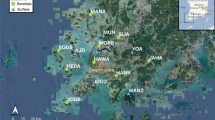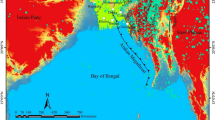Abstract
The Fraser River delta in Greater Vancouver, Canada consists of deep soft deposits of silts and clays, and it is well known that the deep soil deposits can amplify the low frequency contents of ground motions. This study aims to investigate the effects of deep soil deposits in the delta on ground motion amplifications by using thorough site response simulations that account for the full soil profiles and a suite of recorded ground motions that covers a wide range of intensity levels. Based on both equivalent-linear and nonlinear site response simulations, the effects of soil depth (represented by natural period of the soil, TS) on ground motion amplifications for various spectral periods are clearly demonstrated. The ground motion amplification maps for various spectral periods and rock ground motion intensity levels are also generated to be used in the regional seismic hazard assessment for infrastructure. It is found that ground motions for long periods are substantially amplified in the center of the delta, while those for short periods are de-amplified when input rock motions are large.
Similar content being viewed by others
References
Abrahamson NA, Silva WJ and Kamai R (2014), “Summary of the ASK14 Ground Motion Relation for Active Crustal Regions,” Earthquake Spectra, 30(3): 1025–1055.
Ancheta TD, Darragh RB, Stewart JP, Seyhan E, Silva WJ, Chiou BS-J, Wooddell KE, Graves RW, Kottke AR, Boore DM, Kishida T and Donahue JL (2014), “NGA-West2 Database,” Earthquake Spectra, 30(3): 989–1005.
Anderson DL, Byrne PM, DeVall RH, Naesgaard E and Wijewickreme D (2007), Geotechnical Design Guidelines for Buildings on Liquefiable Sites in Accordance with NBC 2005 for Greater Vancouver region, Greater Vancouver Liquefaction Task Force Report, University of British Columbia: 74 pages.
Atkinson GM and Cassidy JF (2000), “Integrated Use of Seismograph and Strong-Motion Data to Determine Soil Amplification: Response of the Fraser River Delta to the Duvall and Georgia Strait Earthquakes,” Bulletin of the Seismological Society of America, 90(4): 1028–1040.
Boore DM, Stewart JP, Seyhan E and Atkinson GM (2014), “NGA-West2 Equations for Predicting PGA, PGV, and 5% Damped PSA for Shallow Crustal Earthquakes,” Earthquake Spectra, 30(3): 1057–1085.
Britton J, Harris J, Hunter J and Luternauer J (1995), “The Bedrock Surface Beneath the Fraser River Delta in British Columbia Based on Seismic Measurements,” Current Resarch 1995-E, Geological Survey of Canada: 83–89.
Campbell KW and Bozorgnia Y (2013), NGA-West2 Campbell-Bozorgnia Ground Motion Model for the Horizontal Components of PGA, PGV, and 5%-Damped Elastic Pseudo-Acceleration Response Spectra for Periods Ranging from 0.01 to 10 s, Pacific Earthquake Engineering Research Center, University of California, Berkeley: 75 pages.
Campbell KW and Bozorgnia Y (2014), “NGA-West2 Ground Motion Model for the Average Horizontal Components of PGA, PGV, and 5% Damped Linear Acceleration Response Spectra,” Earthquake Spectra, 30(3): 1087–1115.
Cassidy JF and Rogers GC (1999), “Seismic Site Response in the Greater Vancouver, British Columbia, Area: Spectral Ratios from Moderate Earthquakes,” Canadian Geotechnical Journal, 36(2): 195–209.
Cassidy JF and Rogers GC (2004), “Variation in Ground Shaking on the Fraser River Delta (Greater Vancouver, Canada) from Analysis of Moderate Earthquakes,” Proceedings of the 13th World Conference on Earthquake Engineering, Vancouver, B.C., Canada: 7 pages.
Cassidy JF, Rogers GC and Weichert DH (1997), “Soil Response on the Fraser Delta to the M W = 5.1 Duvall, Washington, Earthquake.” Bulletin of the Seismological Society of America, 87(5): 1354–1361.
Chenari RJ and Bostani Taleshani SA (2016), “Site Response of Heterogeneous Natural Deposits to Harmonic Excitation Applied to More Than 100 Case Histories,” Earthquake Engineering and Engineering Vibration, 15(2): 341–356.
Chiou BS-J and Youngs RR (2014), “Update of the Chiou and Youngs NGA Model for the Average Horizontal Component of Peak Ground Motion and Response Spectra,” Earthquake spectra, 30(3): 1117–1153.
Clague JJ, Luternauer JL and Mosher DC (1998), Geology and Natural Hazards of the Fraser River Delta, British Columbia, Geological Survey of Canada (Bulletin 525): 270 pages.
Dallimore SR, Edwardson KA, Hunter JA, Lutenauer JL and Clague JJ (1996), Lithologic, Geotechnical and Geophysical Logs from a Deep Borehole at Richmond City Hall, British Columbia. GSC Open File 3356.
Darendeli MB (2001), Development of a New Family of Normalized Modulus Reduction and Material Damping Curves. Civil Engineering, Austin, University of Texas at Austin: 395.
Ewald M, Igel H, Hinzen K-G and Scherbaum F (2006), “Basin-Related Effects on Ground Motion for Earthquake Scenarios in the Lower Rhine Embayment,” Geophysical Journal International, 166(1): 197–212.
Finn WDL, Zhai E, Thavaraj T, Hao XS and Ventura CE (2003), “1-D and 2-D Analyses of Weak Motion Data in Fraser Delta from 1996 Duvall Earthquake,” Soil Dynamics and Earthquake Engineering, 23(4): 323–329.
Frankel A, Stephenson W and Carver D (2009), “Sedimentary Basin Effects in Seattle, Washington: Ground-Motion Observations and 3D Simulations,” Bulletin of the Seismological Society of America, 99(3): 1579–1611.
Graizer V (2016), “Ground-Motion Prediction Equations for Central and Eastern North America,” Bulletin of the Seismological Society of America, 106(4): 1600–1612.
Groholski DR, Hashash YMA, Kim B, Musgrove M, Harmon J and Stewart JP (2016), “Simplified Model for Small-Strain Nonlinearity and Strength in 1D Seismic Site Response Analysis,” Journal of Geotechnical and Geoenvironmental Engineering, 142(9): 04016042.
Hashash YMA, Musgrove MI, Harmon JA, Groholski DR, Phillips CA and Park D (2015), DEEPSOIL 6.1, User Manual: 104.
Hunter J, Dallimore S and Christian H (1997), “Borehole Measurements of Shear Wave Velocity Discontinuities in Quaternary Sediments, Fraser River Delta, British Columbia,” Current Research 1997-A, Geological Survey of Canada: 159–165.
Hunter JA, Burns RA, Good RL and Pelletier CF (1998), “A Compilation of Shear Wave Velocities and Borehole Geophysics Logs in Unconsolidated Sediments of the Fraser River Delta,” British Columbia, Geological Survey of Canada, Open File 3622: 13 pages.
Hunter JA and Christian HA (2001), “use of Shear Wave Velocities to Estimate Thick Soil Amplification Effects in the Fraser River Delta, British Columbia,” Proceedings of the Symposium on the Application of Geophysics to Environmental and Engineering Problems (SAGEEP), March 4–7, 2011, Denver, Colorad.
Kaklamanos J, Bradley BA, Thompson EM and Baise LG (2013), “Critical Parameters Affecting Bias and Variability in Site-Response Analyses Using KiK-net Downhole Array Data,” Bulletin of the Seismological Society of America, 103(3): 1733–1749.
Kim B and Hashash YMA (2013), “Site Response Analysis Using Downhole Array Recordings during the March 2011 Tohoku-Oki Earthquake and the Effect of Long-Duration Ground Motions,” Earthquake Spectra, 29(S1): S37–S54.
Kim B, Hashash YMA, Stewart JP, Rathje EM, Harmon JA, Musgrove MI, Campbell KW and Silva WJ (2016), “Relative Differences between Nonlinear and Equivalent-Linear 1-D Site Response Analyses,” Earthquake Spectra, 32(3): 1845–1865.
Kim B and Shin M (2017), “A Model for Estimating Horizontal Aftershock Ground Motions for Active Crustal Regions,” Soil Dynamics and Earthquake Engineering, 92: 165–175.
Ladd CC (1991), “Stability Evaluation during Staged Construction,” Journal of Geotechnical Engineering, 117(4): 540–615.
Li C, Li H, Hao H, Bi K and Tian L (2018), “Simulation of Multi-Support Depth-Varying Earthquake Ground Motions within Heterogeneous Onshore and Offshore Sites,” Earthquake Engineering and Engineering Vibration, 17(3): 475–490.
Liang F, Chen H and Huang M (2017), “Accuracy of Three-Dimensional Seismic Ground Response Analysis in Time Domain Using Nonlinear Numerical Simulations,” Earthquake Engineering and Engineering Vibration, 16(3): 487–498.
Liu H, Bo J, Li P, Qi W and Zhang Y (2016), “Site Amplification Effects as an Explanation for the Intensity Anomaly in the Hanyuan Town during the Wenchuan M w7.9 Earthquake,” Earthquake Engineering and Engineering Vibration, 15(3): 435–444.
Mazzotti S, Lambert A, Van der Kooij M and Mainville A (2009), “Impact of Anthropogenic Subsidence on Relative Sea-Level Rise in the Fraser River Delta,” Geology, 37(9): 771–774.
Molnar S, Cassidy JF, Olsen KB, Dosso SE and He J (2014a), “Earthquake Ground Motion and 3D Georgia Basin Amplification in Southwest British Columbia: Deep Juan de Fuca Plate Scenario Earthquakes,” Bulletin of the Seismological Society of America, 104(1): 301–320.
Molnar S, Cassidy JF, Olsen KB, Dosso SE and He J (2014b), “Earthquake Ground Motion and 3D Georgia Basin Amplification in Southwest British Columbia: Shallow Blind-Thrust Scenario Earthquakes,” Bulletin of the Seismological Society of America, 104(1): 321–335.
Phillips C and Hashash YMA (2009), “Damping Formulation for Non-Linear 1D Site Response Analyses,” Soil Dynamics and Earthquake Engineering, 29(7): Pages 1143–1158.
Sihua Z and Lung WY (2004), “Seismic Ground Motion Relationship in Southern China Based on Stochastic Finite-Fault Model,” Earthquake Engineering and Engineering Vibration, 3(1): 11–21.
Uthayakumar UM and Naesgaard E (2004), “Ground Response Analysis for Seismic Design in Fraser River Delta, British Columbia,” 13th World Conference on Earthquake Engineering, Vancouver, B.C., Canada, Augus 1–6, 2004, Paper No. 2104.
Vaez Shoushtari A, Adnan AB and Zare M (2018), “Ground Motion Prediction Equations for Distant Subduction Interface Earthquakes Based on Empirical Data in the Malay Peninsula and Japan,” Soil Dynamics and Earthquake Engineering, 109: 339–353.
Walling M, Silva W and Abrahamson N (2008), “Nonlinear Site Amplification Factors for Constraining the NGA Models,” Earthquake spectra, 24(1): 243–255.
Wang H, Xie L, Wang S and Ye P (2013), “Site Response in the Qionghai Basin in the Wenchuan earthquake,” Earthquake Engineering and Engineering Vibration, 12(2): 195–199.
Wijewickreme D (2010), “Cyclic Sheaer Response of Low Plastic Fraser River silt,” Proceedings of the 9th U.S. National and 10th Canadian Conference on Earthquake Engineering, July 25–29, 2010, Toronto, Ontario, Canada, Paper No 1431.
Wong YL, Zhao JX and Luo Q (2002), “Attenuation Characteristics of Ground Motions in Northern China,” Earthquake Engineering and Engineering Vibration, 1(2): 161–166.
Acknowledgement
This research was supported by the 2018 Research Fund (1.170059.01) of UNIST (Ulsan National Institute of Science and Technology) and the National Research Foundation of Korea (NRF) with a grant from the Korean government (MSIT) (NRF-2017R1C1B5074430). The author thanks Dr. Hunter for providing the shear-wave velocity profile data, Dr. Emel Seyhan and Dr. Hamed Ashouri for their assistance in processing the shear-wave velocity profile data, and the anonymous reviewers for their detailed and insightful comments that improved the quality of the manuscript.
Author information
Authors and Affiliations
Corresponding author
Additional information
Supported by: 2018 Research Fund (1.170059.01) of UNIST (Ulsan National Institute of Science and Technology) and the National Research Foundation of Korea (NRF) with a grant from the Korean government (MSIT) (NRF-2017R1C1B5074430)
Rights and permissions
About this article
Cite this article
Kim, B. Mapping of ground motion amplifications for the Fraser River delta in Greater Vancouver, Canada. Earthq. Eng. Eng. Vib. 18, 703–717 (2019). https://doi.org/10.1007/s11803-019-0531-8
Received:
Accepted:
Published:
Issue Date:
DOI: https://doi.org/10.1007/s11803-019-0531-8




